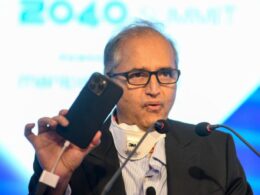Telehealth needs to move from video conferencing for a single service to a logistical structure, says Amwell CEO.
Healthcare IT News
Susan Morse, Editor
May 3, 2022
ATA CEO Ann Mond Johnson speaks to Roy Schoenberg, president and CEO of Amwell, at ATA2022 in Boston
Telehealth must move forward to become not just a substitute for in-person care and a single service, but a “logistical structure” of the healthcare system, according to Roy Schoenberg, president and CEO of Amwell, a telemedicine company based in Boston.
Schoenberg spoke with Ann Mond Johnson, CEO of the American Telemedicine Association, at the ATA2022 session, “Embracing Technology to Shift the Care Balance.”
Telehealth is a convenience for patients, but the majority use it for follow-up care, Schoenberg said. Telehealth must morph, he said.
“People are turning a corner,” Schoenberg said. “If healthcare can set up shop next to its end consumer, through technology, we can completely rewrite how we care for them.”
Telehealth is a convenience for patients, but the majority use it for follow-up care, Schoenberg said. Telehealth must morph, he said.
“People are turning a corner,”… “If healthcare can set up shop next to its end consumer, through technology, we can completely rewrite how we care for them.”
One area ripe for reinvention is care support for patients. For instance, for a patient with cancer, the effect on their life is more than showing up for or the effects of chemotherapy.
“It colors every part of your being,” he said.
One area ripe for reinvention is care support for patients. For instance, for a patient with cancer, the effect on their life is more than showing up for or the effects of chemotherapy.
Through telehealth clinicians can ask them questions every day about how they’re living with the side effects or how they’re eating and sleeping, but this requires healthcare to think about technology completely differently, Schoenberg said.
Through telehealth clinicians can ask them questions every day about how they’re living with the side effects or how they’re eating and sleeping, but this requires healthcare to think about technology completely differently — Schoenberg
There is a growing breed of automated care, which, while an unpopular alternative for some, can be a companion for a patient at 3 a.m. and can alert when it’s time for the physician or clinician to get involved. In this way, telehealth is not a competitor for in-person care.
“We’ve always believed we’re an enabler,” Schoenberg said.
There is a growing breed of automated care, which, while an unpopular alternative for some,
can be a companion for a patient at 3 a.m. and can alert when it’s time for the physician or clinician to get involved. In this way, telehealth is not a competitor for in-person care.
What’s required for telehealth to be relevant in five to 10 years is leadership, technology and the regulatory ability to cross state lines to allow patients in areas such as rural parts of the country to visit a specialist in another state virtually.
What’s required for telehealth to be relevant in five to 10 years is leadership, technology and the regulatory ability to cross state lines to allow patients in areas such as rural parts of the country to visit a specialist in another state virtually.
These regulatory rules are set by state and federal policies.
“As a country we have incredible healthcare resources that can travel, if we let them,” he said.
“Why can’t clinicians that carry that knowledge be in areas of the country not as fortunate? We have to allow clinical services to be available broadly around the country.”
Also, clinicians need to be able to work at the top of their license to increase staffing numbers.
Three years ago, the right technology for telehealth meant good WiFi, he said. Executives must now capture the value that technologies offer.
In 2021, Amwell launched the Converge platform to support integration with EHRs and to improve device connectivity through third-party integrations.
This new addition to the portfolio, Schoenberg said, “recognizes that video conferencing with patients is no longer earth-shattering technology. The staying power of these technologies is whether they can broker healthcare differently. It’s not about video conferencing, it’s the logistics behind it.”
The difference between telehealth technologies that survive and those that do not is the logistics, the EHR integration, the identity management and the security, among other facets.
“It’s really about the choreography of how people are getting together,” he said.
The difference between telehealth technologies that survive and those that do not is the logistics, the EHR integration, the identity management and the security, among other facets.
Originally published at https://www.healthcarefinancenews.com.
Names mentioned
ATA CEO Ann Mond Johnson speaks to
Roy Schoenberg, president and CEO of Amwell, at ATA2022 in Boston












